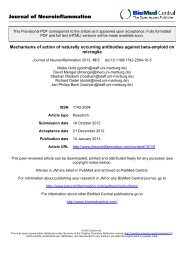View PDF - Journal of Neuroinflammation
View PDF - Journal of Neuroinflammation
View PDF - Journal of Neuroinflammation
Create successful ePaper yourself
Turn your PDF publications into a flip-book with our unique Google optimized e-Paper software.
Krstic et al. <strong>Journal</strong> <strong>of</strong> <strong>Neuroinflammation</strong> 2012, 9:151 Page 2 <strong>of</strong> 23<br />
http://www.jneuroinflammation.com/content/9/1/151<br />
Background<br />
<strong>Neuroinflammation</strong> was one <strong>of</strong> the prominent pathological<br />
features described by Alois Alzheimer in his first<br />
case report in 1907. Today we know that specific markers<br />
<strong>of</strong> neuroinflammation are selectively enriched in<br />
brain areas affected by Alzheimer’s disease (AD) neuropathology<br />
[1], and that individuals with high plaque burden<br />
without dementia show virtually no evidence <strong>of</strong><br />
neuroinflammation [2]. This is further supported by<br />
positron emission tomography (PET) imaging studies,<br />
which have shown that cognitive status is inversely correlated<br />
with microglial activation in patients with AD<br />
[3]. In addition, recent genome-wide association studies<br />
have identified significant correlations between components<br />
<strong>of</strong> the innate immune system and the incidence <strong>of</strong><br />
sporadic AD [4], supporting the link between the immune<br />
system and AD pathophysiology suggested by previous<br />
retrospective epidemiological studies in humans<br />
[5,6].<br />
However, the precise role <strong>of</strong> neuroinflammation in the<br />
disease etiology is still controversial, ranging from representing<br />
a possible cause to being a by-product <strong>of</strong> the disease<br />
[7] or even being beneficial [8]. In 1996 it was<br />
proposed that interleukin (IL)-1, an inflammatory cytokine<br />
whose levels are increased in the brains <strong>of</strong> patients<br />
with AD [9], may represent a driving force in the pathogenesis<br />
<strong>of</strong> AD [10,11]. Although this hypothesis was in<br />
accordance with a meta-analysis <strong>of</strong> 17 epidemiological<br />
studies indicating that non-steroidal anti-inflammatory<br />
drugs might decrease the risk <strong>of</strong> developing AD [12],<br />
subsequent randomized trials not only failed to show a<br />
beneficial effect <strong>of</strong> anti-inflammatory drugs on the etiology<br />
<strong>of</strong> AD [13,14], but in fact found an increase in AD<br />
incidence in patients with mild cognitive impairment<br />
treated with these drugs as compared to placebo [15].<br />
The resolution <strong>of</strong> apparent inconsistency came only recently<br />
with the revision <strong>of</strong> the Alzheimer`s Disease Antiinflammatory<br />
Prevention Trial (ADAPT) hypothesis that<br />
supports a beneficial role <strong>of</strong> anti-inflammatory drugs<br />
only in the early, asymptomatic, phases <strong>of</strong> the disease<br />
[16]. However, in vivo experimental evidence to support<br />
an early and potentially causative role for systemic infections<br />
and neuroinflammation in the etiology <strong>of</strong> sporadic<br />
AD is still missing.<br />
To elucidate the early role <strong>of</strong> inflammatory processes<br />
in the development <strong>of</strong> AD-like pathology in mice, we<br />
used the viral mimic polyriboinosinic-polyribocytidilic<br />
acid (PolyI:C), a synthetic analog <strong>of</strong> double-stranded<br />
RNA, to stimulate the immune system <strong>of</strong> our experimental<br />
animals [17,18]. We have previously shown that<br />
a single exposure to PolyI:C during late gestation triggers<br />
the expression <strong>of</strong> several inflammatory cytokines in<br />
the fetal brain [19], evokes a reduction in adult neurogenesis,<br />
accompanied by memory impairments [19,20], and<br />
accelerates protein depositions in the hippocampus <strong>of</strong><br />
the adult <strong>of</strong>fspring [21]. In the current study, we tested<br />
the hypothesis that the prenatal immune challenge during<br />
late gestation results in pathological aging, and predisposes<br />
the <strong>of</strong>fspring to aging-associated AD-like<br />
neuropathology and cognitive decline [22]. In addition,<br />
we tested the effects <strong>of</strong> systemic immune challenge in<br />
adulthood on the progression <strong>of</strong> the AD-like phenotype<br />
either in prenatally challenged wild-type (WT) mice or<br />
in transgenic AD (3xTg-AD) mice [23].<br />
Methods<br />
Animals<br />
All experimental procedures were approved by the local<br />
authorities <strong>of</strong> the Cantonal Veterinary Office in Zurich<br />
and carried out in agreement with the Principles <strong>of</strong> Laboratory<br />
Animal Care (National Institutes <strong>of</strong> Health<br />
publication number 86–23, revised 1985).<br />
Animals (see Table 1 for a complete list) were housed<br />
in groups <strong>of</strong> three to four in an optimized in-house<br />
hygiene area (University <strong>of</strong> Zurich Irchel, Zurich, Switzerland)<br />
or standard housing conditions in the Laboratory<br />
<strong>of</strong> Behavioural Neurobiology (ETH Zurich, Schwerzenbach,<br />
Switzerland) under a 12 hour light/dark cycle, with<br />
access to food and water ad libitum. Transgenic (3xTg-AD;<br />
encoding APP swe, and TauP301L on a homozygous<br />
PS1M146V knock-in background [23]) and the nontransgenic<br />
mice with the same genetic background (129/<br />
C57Bl6) were obtained from Dr Frank LaFerla, University<br />
<strong>of</strong> California, Irvine, CA, USA. WT C57BL/6 J mice were<br />
obtained from the breeding facility <strong>of</strong> the Institute <strong>of</strong> Laboratory<br />
Animal Science, University <strong>of</strong> Zurich (LTK<br />
Fuellinsdorf).<br />
Polyriboinosinic-polyribocytidilic acid injections<br />
Pregnant mouse dams <strong>of</strong> the C57Bl/6 J strain were given<br />
a single intravenous injection <strong>of</strong> 5 mg/kg PolyI:C potassium<br />
salt (P9582, 50 mg; Sigma-Aldrich Chemie GmbH,<br />
Buchs, Switzerland) dissolved in 0.9% saline (NaCl) with<br />
an injection volume <strong>of</strong> 5 ml/kg body weight or an<br />
equivalent volume <strong>of</strong> saline at gestation day (GD) 17.<br />
The animals were mildly restrained during the injection<br />
procedure using an acrylic mouse restrainer, and after<br />
the injection, were immediately placed back in their<br />
home cage and left undisturbed until the first cage<br />
change at 1 week after delivery.<br />
Behavioral testing<br />
To assess a putative cognitive decline in aged mice<br />
exposed to a prenatal immune challenge, adult<br />
(5 months) and aged (20 months) mice were tested in<br />
the elevated Y-maze spontaneous alternation task<br />
(Table 1). This task is used to measure spatial recognition<br />
memory that depends on proper hippocampal




